Guide to Common Root and Crown Diseases of Cereal Crops in Montana
Dr. Mary Burrows, Extension Plant Pathology Specialist, Montana State University
Contents
- Damping off (Pythium, Fusarium, Rhizoctonia and other fungi)
- Root rot (Pythium, Fusarium, other fungi)
- Rhizoctonia root rot (bare patch) (Rhizoctonia solani)
- Dry seed decay (Penicillum, Aspergillus and other fungi)
- Cephalosporium stripe (Cephalosporium tritici) of winter wheat
- Sharp eyespot (Rhizoctonia cerealis)
- Eyespot/strawbreaker foot rot (Pseudocercosporella herpotrichoides)
- Fusarium crown rot (Fusarium spp.)
- Take-all (Gaeumannomyces graminis var. tritici)
- Snow mold (Typhula, Microdochium)
- Common root rot (Cochliobolus sativus)
- Acknowledgments
Damping off (Pythium, Fusarium, Rhizoctonia and other fungi)
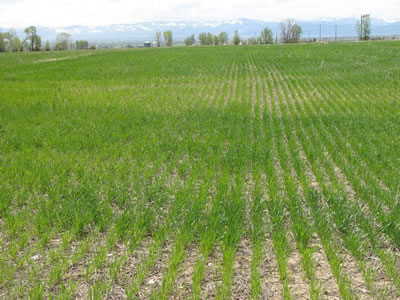
- Symptoms
- Small, yellow plants
- Reduced emergence
- Plants emerge then die
- Risk Factors
- Continuous crop production
- Cool soil temperatures
- Moist soil
- Lack of seed treatment
- Management
- Fungicide seed treatment
- Use a mix of chemistries to target both oomycetes such as Pythium (metalaxyl or mefanoxam) and fungi such as Fusarium and Rhizoctonia
- Fungicide seed treatment
Root rot (Pythium, Fusarium, other fungi)
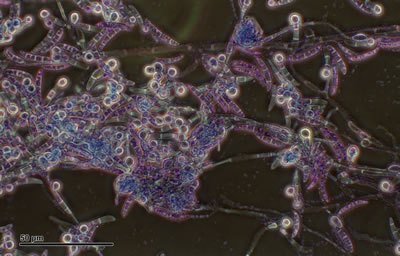
- Symptoms
- Small, yellow plants
- Smaller root mass than healthy plants
- Brown roots
- Outer root cortex easily peels off, leaving the inner stele (vascular system) of the root
- Risk Factors
- Continuous crop production
- Cool soil temperatures
- Moist soil and continued cool temperatures during early crop growth
- Lack of seed treatment at planting
- Management
- Seed treatments are effective for 2-3 weeks after planting.
Rhizoctonia root rot (bare patch) (Rhizoctonia solani)
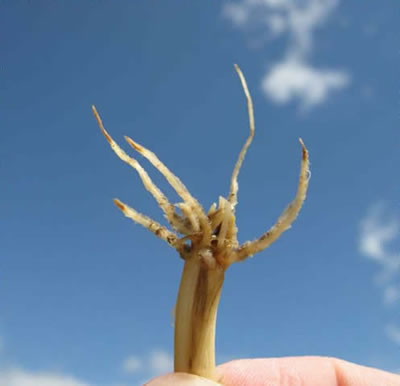
- Symptoms
- Similar to damping off and dry seed decay
- Spear-tipping of roots when they are washed (tapered, dark brown or black root tips)
- Risk Factors
- Continuous cereal crop production
- Spraying glyphosate on volunteer and grassy weeds and planting seed within a few days
- Management
- Variety selection
- Soil pH modification with potash is limited in effectiveness
Dry seed decay (Penicillum, Aspergillus and other fungi)
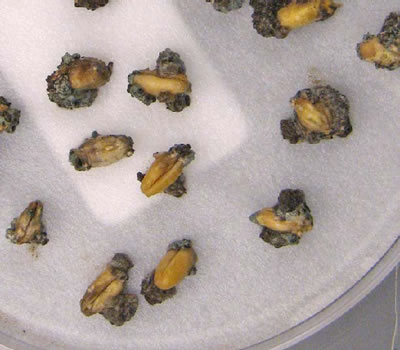
- Symptoms
- Seeds may decay in the soil or seedlings may become blighted and killed below the soil surface
- Stands are thin and uneven or lacking plants in small to large areas
- Seeds may be covered with green or white fungal mycelia, soil may stick to seeds
- Risk Factors
- Planting into dry soil with no moisture for 2-3 weeks after planting
- Lack of seed treatment
- Management
- Fungicide seed treatment
Cephalosporium stripe (Cephalosporium tritici) of winter wheat
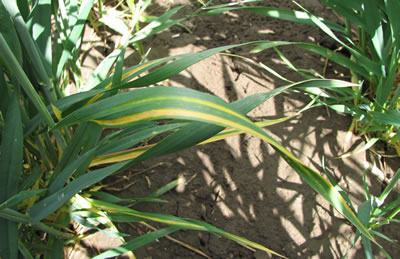
- Symptoms
- Dwarfed plants with one or two continuous yellow stripes on the leaf
- Nodes on stem may be darkened
- White heads at maturity
- Risk factors
- Continuous winter wheat cropping
- Freeze-thaw cycles which allow the fungus to enter the roots
- Early seeding
- Management
- Variety selection
- Crop rotation
- Delayed planting
- Tillage
Sharp eyespot (Rhizoctonia cerealis)
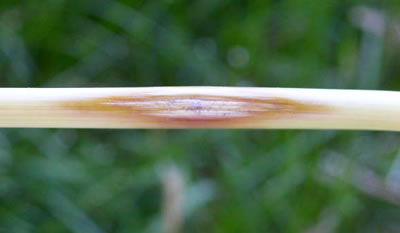
- Symptoms
- Lesions on crown elongated eye-shape
- Dark halo surrounding tan center
- White heads at maturity
- Lodging; infects through leaf sheath, lesions often start on external leaf sheath and expand into center of stem
- Girdling plant
- Risk factors
- Continuous cereals
- No-till with crop residue
- Moist, cool weather
- Management
- Crop rotation
- Variety selection
- Irrigation management to reduce humidity in the canopy
- Light tillage to reduce residue
- Fungicide application
Eyespot/strawbreaker foot rot (Pseudocercosporella herpotrichoides)
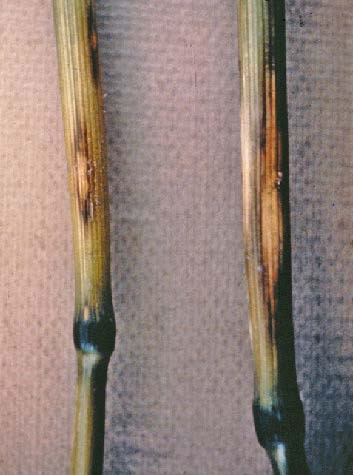
- Symptoms
- Lesions on crown elongated eye-shape
- Dark halo surrounding brown center
- White heads at maturity
- Lodging; infects through leaf sheath, lesions often start on external leaf sheath and expand into center of stem
- Girdling plant
- Risk factors
- Continuous cereals
- No-till with crop residue
- Moist, cool weather
- Management
- Crop rotation
- Variety selection
- Irrigation management to reduce humidity in the canopy
- Light tillage to reduce residue
- Fungicide application
Fusarium crown rot (Fusarium spp.)
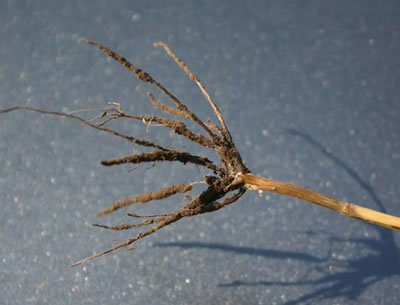
- Symptoms
- Brown discoloration of subcrown internode and first two nodes of the crown
- White heads at maturity
- Risk factors
- Continuous wheat production
- No-till with wheat crop residue
- High nitrogen
- Soil moisture fluctuations
- Management
- Crop rotation
- Variety selection
- Proper fertilization
- Irrigation management to maintain continuous moisture
- Light tillage to reduce residue where applicable
Take-all (Gaeumannomyces graminis var. tritici)
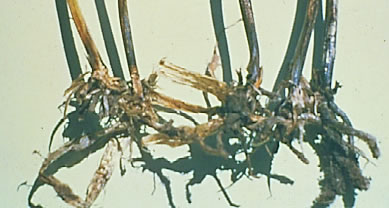
- Symptoms
- Solid or streaked obsidian-black discoloration of first one or two nodes of the crown
- Black discoloration of subcrown internode
- White heads at maturity
- Risk factors
- Continuous wheat production (although after many years of continuous wheat there may be take all decline, a reduction in disease)
- No- till with wheat crop residue
- High soil pH
- Nutritional stress
- Management
- Crop rotation
- Variety selection
- Proper fertilization
- Grassy weeds control
- Light tillage to reduce residue where applicable
Snow mold (Typhula, Microdochium)
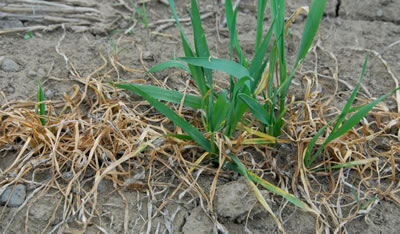
- Symptoms
- Speckled snow mold (Typhula)
- Leaves are bleached white/ tan, small dark fungal structures (sclerotia) scattered
- Pink snow mold (Microdochium)
- Pink fungal structures (mycelium, conidia) on yellow or dying leaves
- Speckled snow mold (Typhula)
- Risk factors
- Prolonged deep snow
- Management
- Crop rotation
- Early seeding to develop larger, more tolerant plants
Common root rot (Cochliobolus sativus)
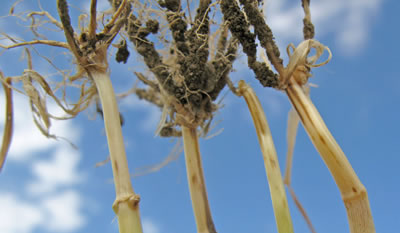
- Symptoms
- Brown to black, often streaky discoloration of first one or two nodes of the crown
- Dark brown spots on subcrown internode
- White heads at maturity
- Risk factors
- Continuous wheat production
- No-till with wheat crop residue
- High nitrogen
- Soil moisture fluctuations
- Management
- Crop rotation
- Variety selection
- Proper fertilization
- Irrigation management to maintain continuous moisture
- Light tillage to reduce residue where applicable
Acknowledgments
Photos courtesy of MSU Plant Pathology Department slide collection; Jeff Johnston, Plant Sciences and Plant Pathology, MSU; Larry Osborne, South Dakota State University; Tim Murray, Washington State University; CIMMYT; and HGCA; Wikimedia Commons.
